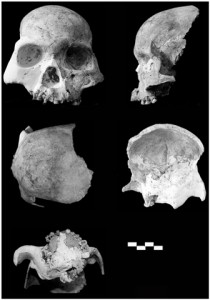Who were the Red Deer People?
A paper published in the online scientific journal PLoS One (public library of science) details the discovery and analysis of ancient human remains which may provide evidence that south-western China was once populated by an ancient species of hominids, a species that is entirely new to science.
The Red Deer People
An international team of researchers including scientists from the University of New South Wales (Australia) have been analysing the fragmentary fossil remains of ancient humans, their studies show that these humans have a mix of both modern and ancient traits. They could be the last vestiges of a hominid that survived to the Pleistocene/Holocene transition or perhaps evidence that our own species interbreed with more ancient hominids on arrival in Asia. Dating work including analysis of charcoal deposits left by the cave people as they cooked their food suggest that the fossils are between 14,300 and 11,500 years old – very recent in terms of the geological record.
Team co-leader Darren Curnoe, of the University of New South Wales, commented that the physical appearance of these extinct people was unique, like nothing seen in the Asian hominid record to date.
He stated:
”They look very different to all modern humans, whether alive today or in Africa 150,000 years ago.”
Skeletal Evidence
Skeletal evidence and the results of DNA analysis indicate that our species evolved in Africa before migrating and populating every continent. It is thought that modern humans migrated into Asia across the Arabian peninsula something like 60,000 years ago. Evidence from early H. sapiens and H. neanderthalensis sites is open to a number of interpretations as the archaeological record suggests a complex migration pattern with groups of modern humans and Neanderthals moving in and out of the region in response to changing climate. The Tibetan plateau may have acted as a natural barrier permitting an ancient hominid species that may have migrated through the Indian sub-continent and eventually present in south-west China to remain excluded from the incursions of more modern species.
Pleistocene aged human fossils are rare in East Asia. Finds are very scarce but a number of discoveries in south-western China are helping to document the history of human migration into that part of the continent. This international team, studied a partial skull which was carefully extracted from a block of sediment collected in 1979 from the Longlin Cave (Guangxi Province). Although the fossil had been found nearly 35 years ago, it had not been properly studied. This specimen was compared to other human remains found at a cave known as the “Red Deer Cave” due to the number of fossil deer bones found (Maludong, Yunnan Province), mostly fragmentary specimens but as yet undescribed human bones. The bones found at these different locations suggest that they represent a single population, one type of people with a mixture of ancient and modern anatomical characteristics.
The Partial Human Skull (Longlin Cave)
Picture credit: PLoS One/Curnoe et al.
The prehistoric people had short, flat faces with ancient features reminiscent of H. heidelbergensis such as thick skull bones and big teeth but brains with modern-looking frontal lobes. Known as the “Red Deer People” due to their apparent reliance on an extinct species of deer for food, these humans are the youngest people in terms of geological age, found to date that do not resemble our own human species.
Two Possible Explanations
The research team have put forward two possible explanations for the existence of this unknown human species in this region. Firstly, they could be modern humans (H. sapiens) that migrated out of Africa very early and reached China independently of other human migrations out of Africa. Once in China these people did not contribute genetically to people living in East Asia today.
Secondly, the fossil material could represent an unknown species of hominid, deer hunting, venison eating people who lived at a time when our own species was adopting a more sedentary existence rather than the hunter/gatherer way of life, with the development of agriculture.
Although cautious, Professor Curnoe favours the new human species theory, he stated:
”While finely balanced, I think the evidence is slightly weighted towards the Red Deer Cave people representing a new evolutionary line.”
The find follows the discoveries of two new human species in Asia, dubbed “the Hobbit”, (H. floresiensis) due to their small size and the Denisovans, in the last decade or so. The Indonesian island of Flores was home to a diminutive species of hominid up until approximately 13,000 years ago.
To read more about the Denisovans: X-woman Competing with Modern Humans and Neanderthals.
The discovery team, co-led by Professor Curnoe and Professor Ji Xueping, of Yunnan University in Kunming, includes researchers from five Australian and six Chinese institutions. This work is invaluable in helping archaeologists and palaeontologists to piece together the human family tree.
The scientific paper: “Human Remains from the Pleistocene-Holocene Transition of Southwest China Suggest a Complex Evolutionary History for East Asians” by Curnoe et al published in PLoS One.
For models and replicas of Neanderthals: CollectA Prehistoric Life Models.






Leave A Comment